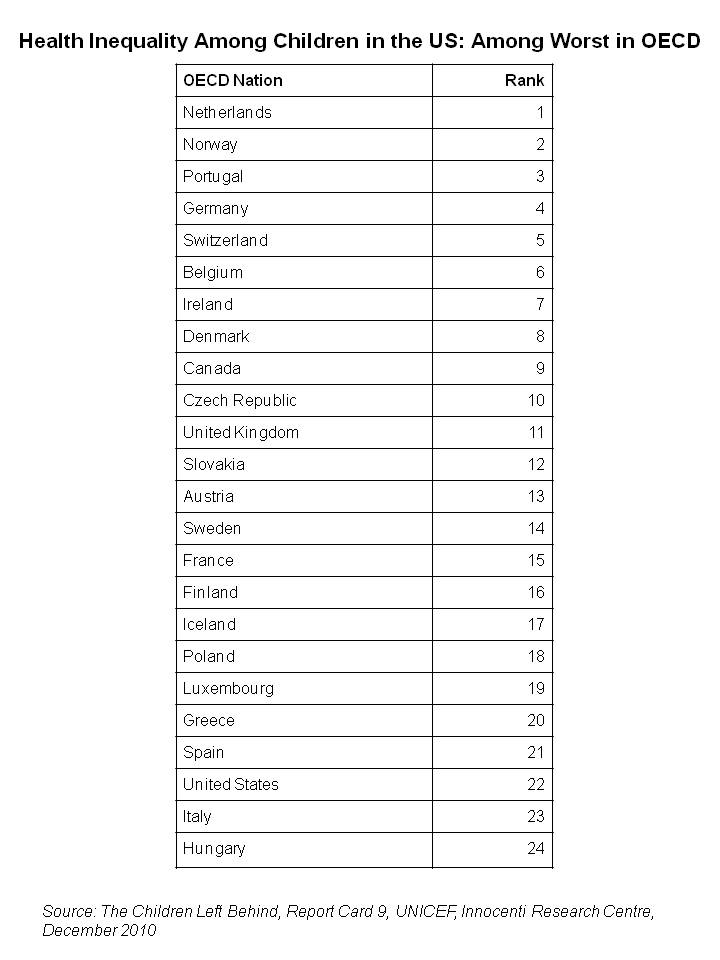 In a nation where ‘no child left behind’ has been a mantra, it’s clear that in the U.S., many children are left behind when it comes to health. UNICEF’s Report Card #9 is out from the Innocenti Research Centre, providing the league table for child well-being in the world’s 24 richest countries.
In a nation where ‘no child left behind’ has been a mantra, it’s clear that in the U.S., many children are left behind when it comes to health. UNICEF’s Report Card #9 is out from the Innocenti Research Centre, providing the league table for child well-being in the world’s 24 richest countries.
In health inequality — that is, the gap between kids who have ‘average’ well-being in the U.S. and those who fall below — the U.S. ranks #22 among the 24 wealthiest nations in the world. While an educated guess might put U.S. kids’ health inequality below Switzerland, Norway, and Denmark, the sad surprise in the data are that U.S. children fall well behind places like the Czech Republic, Poland and Slovakia. The chart summarizes the rankings for the 24 OECD countries studied by UNICEF. Only Italy and Hungary’s children have greater “bottom-end inequality” (a UNICEF term) than American kids.
UNICEF found that the countries with the highest median levels of health — the Netherlands, Austria and Portugal — also have the lowest levels of health inequality.
“Whether in health, in education, or in material well-being, some children will always fall behind the average,” the report recognizes. “The critical question is — how far behind? Is there a point beyond which falling behind is not inevitable but policy susceptible, not unavoidable but unacceptable, not inequality but inequity?”
UNICEF based data on child well-being based on data from a World Health Organization survey, Health Behaviour in School-aged Children among children 11, 13 and 15. Young people were asked how often in the previous six months they had experienced the following problems: headache, stomach ache, feeling low, feeling irritable, feeling bad tempered, feeling nervous, having difficulty getting to sleep, and, feeling dizzy.
Health Populi’s Hot Points: Inequality in health is driven by socioeconomic status. In Closing the Gap in a Generation, WHO observes that, ” Increasingly the nature of the health problems rich and poor countries have to solve are converging. The development of a society, rich or poor, are judged by the quality of its population’s health, how fairly health is distributed across the social spectrum, and the degree of protection provided from disadvantage as a result of ill-health.”
In the U.S., the gap between health-rich and health-poor is widening. From East LA to Detroit, Bangor, Maine to New Orleans, health inequities and disparities can look like those between the south side of Chicago and Nairobi or Dharavi, India.’
Health policies that address unequal health for children (and older people too) have as much to do with income security, job security, safe water and healthy and accessible food supplies. Good health comes from vaccines and basic medicines, surely; but also from the ability to read, secure and hold a decent job, and get a good education.
When children fall behind in education and economic standing, they ultimately lose in health. The longer-term consequences morph from teenage pregnancies and alcohol and drug dependence, to behavioral difficulties and welfare dependence.




 Thank you, Jared Johnson, for including me on the list of the
Thank you, Jared Johnson, for including me on the list of the  I am so grateful to Tom Lawry for asking me to pen the foreword for his book, Health Care Nation,
I am so grateful to Tom Lawry for asking me to pen the foreword for his book, Health Care Nation,  Thanks to Feedspot for naming this blog, Health Populi, as a
Thanks to Feedspot for naming this blog, Health Populi, as a